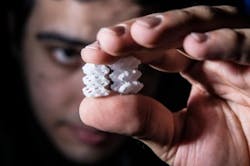Modified laser cutting system becomes an open-source laser sintering platform
Bioengineers at Rice University (Houston, TX) modified a commercial CO2laser cutting system to create OpenSLS, an open-source, selective laser sintering (SLS) platform that can print intricate 3D objects from powdered plastics and biomaterials. The system costs at least 40 times less than its commercial counterparts and allows researchers to work with their own specialized powdered materials.
OpenSLS, which was built using low-cost, open-source microcontrollers, cost less than $10,000 to build—commercial SLS platforms typically start around $400,000 and can cost up to $1 million. Study co-author Jordan Miller, an assistant professor of bioengineering at Rice University who specializes in using 3D printing for tissue engineering and regenerative medicine, explains that commercial SLS machines generally do not allow users to fabricate objects with their own powdered materials, which is something that is particularly important for researchers who want to experiment with biomaterials for regenerative medicine and other biomedical applications.
"Designing our own laser-sintering machine means there's no company-mandated limit to the types of biomaterials we can experiment with for regenerative medicine research," says study co-author Ian Kinstlinger, a graduate student in Miller's group who designed several of the hardware and software modifications for OpenSLS. The team showed that the machine could print a series of intricate objects from both nylon powder—a commonly used material for high-resolution 3D sintering—and from polycaprolactone (PCL), a nontoxic polymer that is commonly used to make templates for studies on engineered bone.
OpenSLS works differently than most traditional extrusion-based 3D printers, which create objects by squeezing melted plastic through a needle as they trace out 2D patterns. Three-dimensional objects are then built up from successive 2D layers. In contrast, the SLS laser shines down onto a flat bed of plastic powder. Wherever the laser touches powder, it melts or sinters the powder at the laser's focal point to form a small volume of solid material. By tracing the laser in two dimensions, the printer can fabricate a single layer of the final part.
Miller, an active participant in the open-source maker movement, first identified commercial CO2 laser cutters as prime candidates for a low-cost, versatile selective sintering machine in early 2013. "The cutter's laser is already in the correct wavelength range—around 10µm—and the machines come with hardware to control laser power and the x-axis and y-axis with high precision," he says.
In summer 2013, Miller hosted a four-week crash course in hardware prototyping called the Advanced Manufacturing Research Institute (AMRI), and AMRI participant Andreas Bastian, an artist and engineer, took on the challenge of creating the open-source SLS printer. He designed an integrated, high-precision z-axis and powder-handling system and fitted it with open-source, 3D printer electronics.
Kinstlinger addressed each possibility with PCL by developing an efficient way to smooth the rough surfaces of PCL objects that came out of the printer. He found that exposing the parts to solvent vapor for short time periods (around 5 min.) provided a very smooth surface because of surface-tension effects. In tests using human bone marrow stromal cells—the type of adult stem cells that can differentiate to form bone, skin, blood vessels, and other tissues—Kinstlinger found that the vapor-smoothed PCL structures worked well as templates for engineered tissues that have some of the same properties as natural bone.
For more information, please visit https://youtu.be/BCbDFt0MbTY.
